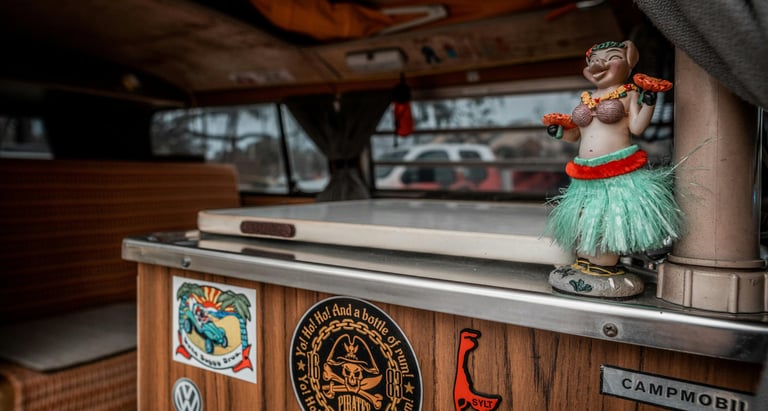The Ultimate Guide To Insulating A Campervan
Struggling to keep your campervan cosy in the winter or cool during the summer? Discover the science, materials & methods behind perfect campervan insulation. Let's walk through every step of adequately insulating a Campervan
9/18/202312 min read
The subject of insulation comes up whether you're building your first or fifth campervan. It's a variation on the age-old query of campervan builders: What is the best option? There are many benefits and drawbacks to each approach, and everyone has an opinion. But we've taken on the task of writing the most thorough guide to insulation, covering everything from initial planning to final installation.
Your comprehensive guide to all the procedures and material selections will be this post. We have divided it into multiple natural pieces to make it easier for you to follow along. When you're finished, you'll be an expert in campervan insulation, prepared to stay cool on sweltering summer days and toasty on chilly winter evenings.
Are you ready? Let's get right to the point by dissecting everything, from the materials to the underlying science, to provide you with the finest circumstances for your campervan life.
Part 1: The fundamentals of maintaining your campervan comfort


1. _What is insulation and why is it a year-round necessity?
If you believe that insulation is only necessary in cold weather, you should reconsider. Insulation's main goal when converting a van to a campervan is to create a stable inside atmosphere, whether it's sweltering hot in July or freezing cold in December. It helps keep the heat out in hot weather and keep you warm in cold weather.
2. What distinguishes radiation isolation from mass isolation?
However, what is the true mechanism of insulation? We frequently discuss "heat," but in reality, heat is just energy that travels, and it prefers to enter (or exit) your campervan in many ways. There are three primary ways that heat is transferred: conduction, convection, and radiation transfer. All three processes can play tricks on you, regardless of the season, so be prepared!
3. _Thermal bridges: What are they?
Lastly, we must discuss thermal bridging, one of the most prevalent issues with campervan insulation. Your van's thermal bridges are the sections that serve as thermal highways, allowing heat (or cold) to move swiftly through conductive materials from the outside to the inside. Specifically, when heat seeps through the walls
4. _Use appropriate insulation
Have you ever woken up to the sound of the motor reverberating into the campervan or to sudden sounds coming from the street outside? Get advice on how to make your campervan seem quiet and private, regardless of where you park, and discover the distinction between direct and indirect soundproofing.
Whether you are in sweltering heat or bitter cold, you can keep your campervan at a pleasant temperature with the correct insulation. Despite the widespread belief that insulation is only necessary in the winter, adequate insulation has a significant impact on your ability to stay warm in the winter and cool in the summer.
In addition to helping you select the best insulation material for your campervan, this book will explain how insulation functions, common flaws to look out for, and the lessons we've discovered from our do-it-yourself campervan projects.
Why should you care about heat transfer?
Conduction, convection, and radiation transfer are the three primary methods of heat transmission. All of these mechanisms have the potential to either release the heat you truly need on chilly evenings or release it when you least expect it (imagine a field under a blazing sun). Let's examine these ideas in more detail.
Conduction heating is sheet metal's worst enemy.
Of all the heat transfer methods, conductive heating is arguably the most traditional and a major problem in campervans. Imagine that the heat travels through the metal and reaches your fingertips, much like when you hold a spoon in a hot cup of tea or a hot pot handle. Or why not on a sunny day when your van's sheet metal warms up inside the cargo area? What is going on?
The heat or cold is transferred straight into the interior of your car when the sheet metal is heated by the sun or chilled in the winter. In particular, metal is an excellent heat conductor, which we appreciate when we brew coffee but detest when we have to keep the temperature in our vehicle constant. Consequently, you should consider utilizing insulation that serves as a partition between the metal and the remainder of the van's inside.
Convection is the process by which warm air tends to move upward.
The movement of air is known as convection. You have likely observed cold water sinking to the bottom of a lake or warm air rising above a hot element. The same thing happens in your ventilation system in the car – the heat flows with the air current in your car's ventilation system.
Warm air rises and cold air falls – and if you don't insulate properly, you can see your heat floating out of the ceiling. When it comes to your campervan, you want to minimize these drafts as much as you can with your campervan.
Isolate for radiation,
The sun isn't always on your side
This is when the heat is transferred via electromagnetic waves, so the kind of heat you feel when the sun shines on your van. In the summer, you want to avoid your camper van turning into an oven, and in the winter,r you don't want the little heat you've generated to radiate through the walls. Therefore, you need protection against radiant heat, such as reflective materials.
So, if you want to keep the temperature down, a glossy surface can be your best friend!
Your "fluffy" companion is mass insulation.
The kind of insulation that you might be most familiar with is bulk insulation, like foam or wool. It effectively counteracts both conduction and convection heat by trapping air and slowing down heat transfer. Consider it your van's blanket; the fluffier it is, the better the insulation!
Radiation isolation – The reflective shield
Radiant insulation, on the other hand, reflects heat rather than absorbing it. Foils are frequently used here because they reflect the heat from the sun and keep your van from turning into an oven during the summer. Reflecting heat inside the vane, this also serves the opposite purpose in the cold.
Thermal bridges - The deadliest adversary you have
The deadliest adversary you have is thermal bridges. The phenomena known as thermal bridges must be mentioned when discussing heat transmission since it has the potential to undo all of your hard work in insulation. A thermal bridge is created when heat (or cold) is swiftly transferred from the exterior to the interior through conductive materials, and there is an uninterrupted path for heat to be conducted. This typically refers to metal components found in campervans, including the bodywork or any screws and fasteners that allow heat to pass through the insulation.
For instance, have you completely insulated your van's walls but neglected to cover a metal beam? Due to the free passage of heat, the beam then functions as a heat conductor, producing a cold surface or a warm surface in the summer.


What is Heat Transfer and Why Should It Matter to You?
Heat can be transferred in three primary ways: conduction, convection, and radiation. These processes can let unwanted heat into your campervan on a scorching summer day or allow precious warmth to escape on chilly winter nights. Let’s dive deeper into these concepts.
Conductive Heat – The Nemesis of Metal Panels
Conductive heat transfer is perhaps the most traditional form of heat transfer and a major culprit in campervan insulation challenges. Think of it as the warmth spreading through a hot saucepan handle or a spoon left in a cup of tea—it travels through the metal right to your fingers. Or imagine the metal panels of your campervan heating up inside the cargo area on a sunny day. What’s happening here?
When your campervan’s metal exterior is warmed by the sun or cooled by winter temperatures, the heat or cold is directly transferred into the interior. Metal is an excellent conductor of heat—a feature we appreciate when brewing coffee but loathe when trying to maintain a comfortable temperature in a campervan. That’s why it’s essential to use insulation that acts as a barrier between the metal and the rest of your van’s interior.


How does it work?
The vibrations of the atoms store the heat. The energy and vibrations increase with the amount of heat. Heat spreads farther when atoms meet with one another. Atoms in a denser material are closer to one another and can transfer heat more easily.
Insulated conductor:
Less dense materials are better at preventing heat transmission, hence, they are the ideal choice for controlling conduction.
How does it work?
All hot objects emit electromagnetic waves and can heat other objects from a distance. It's critical to seal air gaps and insulate hollow structures like frames to reduce heat loss from convection. It lessens heat loss by decreasing air circulation.
Isolate for radiation:
A white or glossy surface absorbs and emits heat poorly, making it a good barrier against radiant heat. So if you want to keep the temperature down, A white or glossy surface absorbs and emits heat poorly, making it a good barrier against radiant heat. So if you want to keep the temperature down, a glossy surface can be your best friend.
How does it operate?
Heat is "transported" from one part of the liquid or gas to another by the hotter material rising and being replaced by colder material sinking. So when hotter material rises and is replaced by cooler material sinking, heat is "transported" from one area of the liquid or gas to another. The temperature is regulated by this natural cycle.
Insulate for convection:
It's critical to seal air gaps and insulate hollow structures like frames to reduce heat loss from convection. It lessens heat loss by decreasing air circulation.
Condensation and moisture control:
Vapor barrier or not?
A vapor barrier's function is to stop damp air from escaping to cold surfaces from within the van. Breathing, cooking, or drying damp clothing can all cause this. We want to prevent condensation from forming when damp air comes into contact with chilly surfaces. It will be challenging to remove the moist air if it does manage to pass through the vapor barrier since it will be trapped between two barriers (keep in mind that metal also functions as a vapor barrier).
There are still ways for damp external air to get in even if you are successful in building the ideal vapor barrier, which is sadly challenging. Leakage points are always possible.
Even if you were to succeed in creating the perfect vapor barrier (which is difficult, unfortunately), there are still pathways for moist outdoor air to enter. There are always possible leakage points.
Therefore, we choose to let the insulation layers "breathe" and not to use a vapor barrier.
Moisture and condensation a complex subjects about which there is much more to say. Hopefully, this post will help you understand the phenomenon better and allow you to make a more informed decision about your insulation.


Want to learn more?
Click here to read more about Condensation and Moisture
Sound-proofing
A Quieter and More Comfortable Campervan


Soundproofing – The first step to a quieter campervan
When we talk about insulating a campervan most people consider temperature control when discussing campervan insulation, but sound insulation is also a crucial consideration. Nobody wants to wake up at five in the morning to the sound of traffic or the roar of the wind.
An effective soundproofing system can mean the difference between a restful night's sleep and a frustrating one. However, how does sound insulation function in practice, and what are some ways to keep your van comfortable and quiet? Let's investigate!
Direct and indirect sound insulation,
What's the difference?
The goal of direct soundproofing is to prevent sound from entering or leaving the van through the floor, ceiling, or walls. Sound waves are absorbed and stopped by this kind of insulation. Consider it like a sturdy front door in a house: the denser and thicker the material, the more difficult it is for sound to pass through.
By lowering resonance and vibration, indirect soundproofing, on the other hand, aims to reduce and manage sounds that are already present inside your campervan. This could be anything from lowering tire, engine, and road noise to stopping the floor from bouncing while you drive over obstacles.
This is how sound behaves in a Campervan
Knowing how sound works is essential to knowing how to soundproof your campervan. Simply put, sound is made up of air vibrations that travel in waves. The material begins to vibrate when these sound waves strike it, such as the walls of your campervan, producing sound within.
Because of their propensity to shake and allow a lot of noise to pass through, thin, hard surfaces like sheet metal are especially poor in absorbing sound. You can lessen these vibrations and maintain a low noise level by covering the walls with material that absorbs sound.
Damping material – Stop the vibrations
Damping materials like Dynamat or Noico are common options for lowering indirect noise from vibrations. These are self-adhesive mats that are applied to sheet metal in floors, walls, and ceilings. By making the plate firmer and more difficult to shake, they considerably lower the noise level. These materials are great in a campervan and are frequently used in engines and automobile stereos to reduce noise and resonance.
I have personally tried and experimented with a variety of bitumen-based substitutes, ranging from BRL Silent Coat Vibrodamping to various Biltema variations. There are differing suggestions, ranging from 25% to 100%, like with many other things.
We decided to use the following approach because there are rapidly expanding areas to cover: Dress to a quarter, then add supplements and knock from the outside. Keep in mind that the bigger sheet metal surfaces require the most stabilization, therefore, the inner surface can be divided into separate "sheet metal windows" since the supporting framework, including beams and other components, is typically stiffer from the ground up. We experienced a sense, particularly after we opened the bulkhead. If you plan to bike extended distances with a fully or partially open bulkhead, this is practically a must.
A junction between the beam and the bigger sheet metal surfaces can help if the vehicle is older and the sheet metal frequently strikes the road when traveling on the highway.
Bonus advice: Use a heat gun or wait until it's a little warmer outside before getting too excited! The first time, we braved the cold since we wanted to begin the conversion as soon as possible. The task took a lot longer than if we had waited for the spring sun, despite the fact that we used the heat gun a lot.


Sound Insulating Materials For Campervan
The useful part is here: what supplies are best for soundproofing your campervan? Similar to thermal insulation, there are numerous possibilities, and the key to achieving the greatest results is combining various materials.
Absorbent material – Captures the sound waves
You need materials that can absorb sound waves and stop them from bouncing around in order to block direct sound, such as outside noise. Foam rubber and mineral wool, such as fiberglass or Armaflex insulation, are great options. By forming tiny air pockets where sound waves are "stuck" and muted, these materials absorb sound. These can be used to reduce noise and resonance in floors, walls, and ceilings.
Road noise easily wears you out if you drive a lot in a day. It's simple to make a mistake and mix up the terms "capturing sound waves" and "stopping vibrations" while trying to reduce the sound that passes through the wheel arches.
First, using an absorbent material like Armaflex or something similar is the most efficient approach to insulating around the wheel arches to lessen tire noise. Additionally, keep in mind that textiles attenuate sounds that would otherwise reverberate freely in the cabinet in addition to making it a bit cozier.
Integrate insulation for sound and heat
Combining heat-insulating and soundproofing materials is one of the finest ways to create a warmer and quieter home. In reality, a lot of soundproofing solutions, like the ones we just discussed, also serve as thermal insulation. Armaflex, for instance, can aid in sound absorption in addition to being utilized as insulation against heat and cold. This implies that your investment in comfort and acoustic quality yields double returns! However, you are welcome to mix the Armaflex with a mass insulator, such as wool.
Heat and sound can also be blocked by adding a layer of reflective material, like foil insulation or Reflextex, particularly if it is strategically placed beneath the floor or behind wall panels.


Tips for effective sound insulation
in the camper van
Cover every surface: In addition to the obvious areas to start—walls, floors, and ceilings—doors and wheel arches can also be significant sources of noise. Cushioning around these can have a significant impact.
Seal any gaps and crevices: Since sound may enter via even the slightest gap, make sure to caulk windows, doors, and any other potential flaws. Foam and sealing strips are easy fixes.
Insulate beneath the floor: Noise from the road, in particular, can be a major source on the floor. Your ride will be quieter and less jarring if you place a thick layer of dampening material underneath your floor mat.
Employ textiles: Soft materials that absorb sound, such as carpets, drapes, and upholstered furniture, also lessen the amount of sound that bounces around in the campervan. So, in addition to being comfy, a soft duvet or pillow can help absorb sound!
In conclusion
The secret to a quiet and serene campervan is a combination of direct and indirect sound isolation.
Regardless of whether you are parked in a bustling metropolis or a rural area, you may create a peaceful and comfortable atmosphere by employing the appropriate items in the appropriate locations. Additionally, your van will be cooler in the summer and warmer in the winter with the proper insulation, a true win-win situation!




Guide
Your resource for camper van electrical systems.
Contact us
Support
© 2024. All rights reserved.
